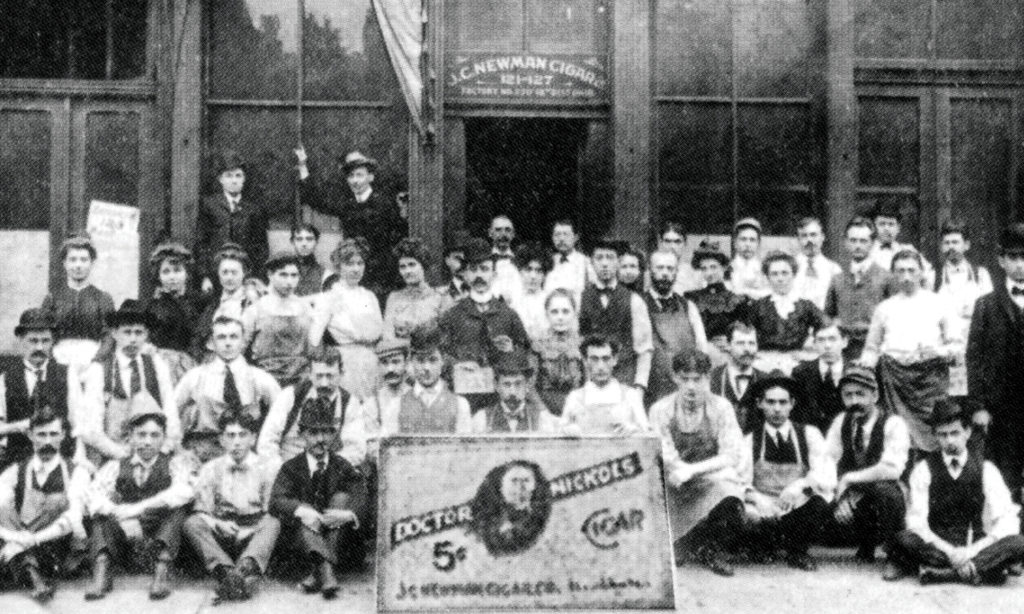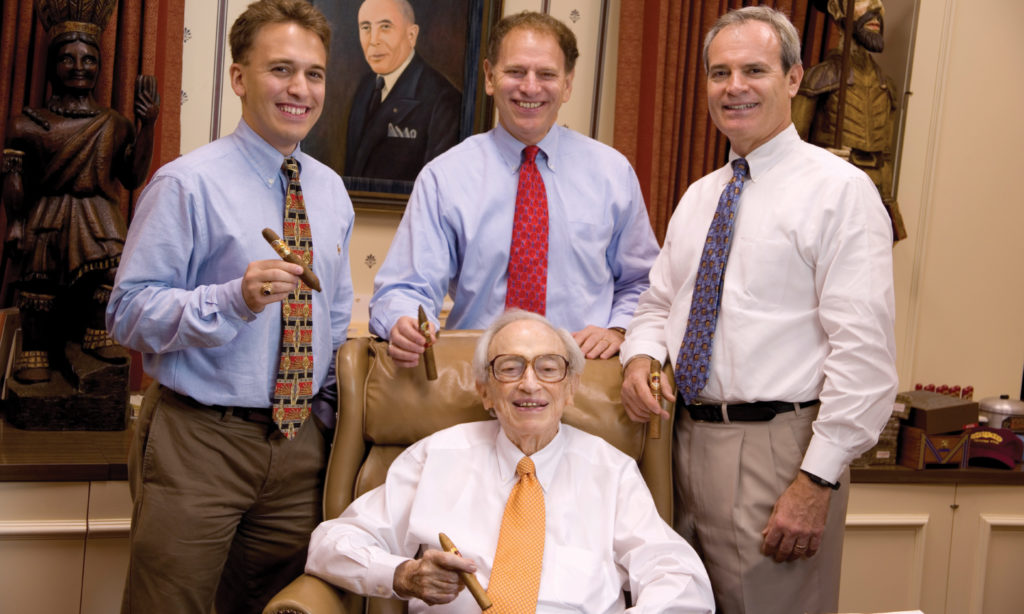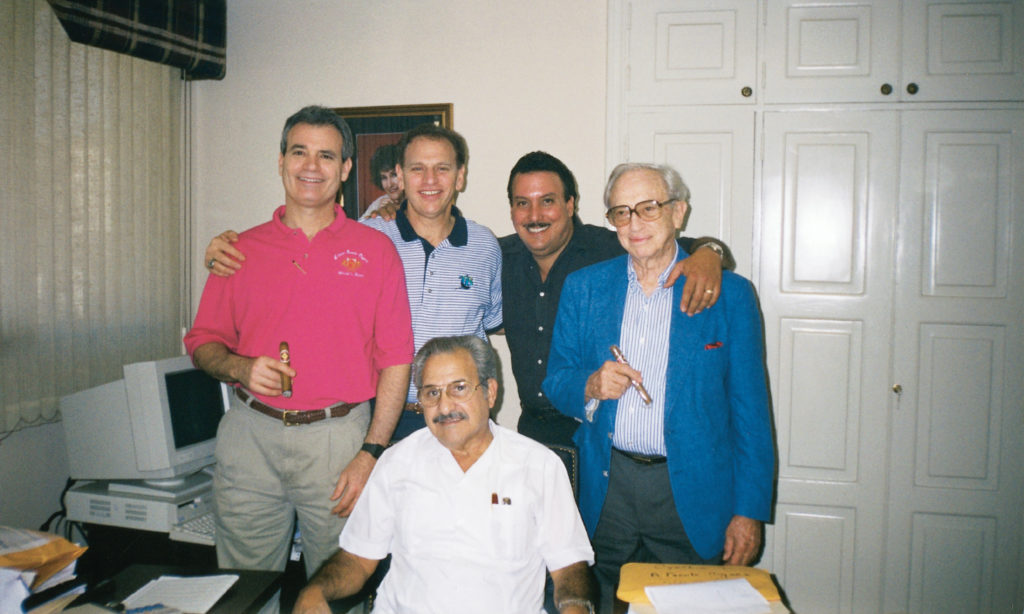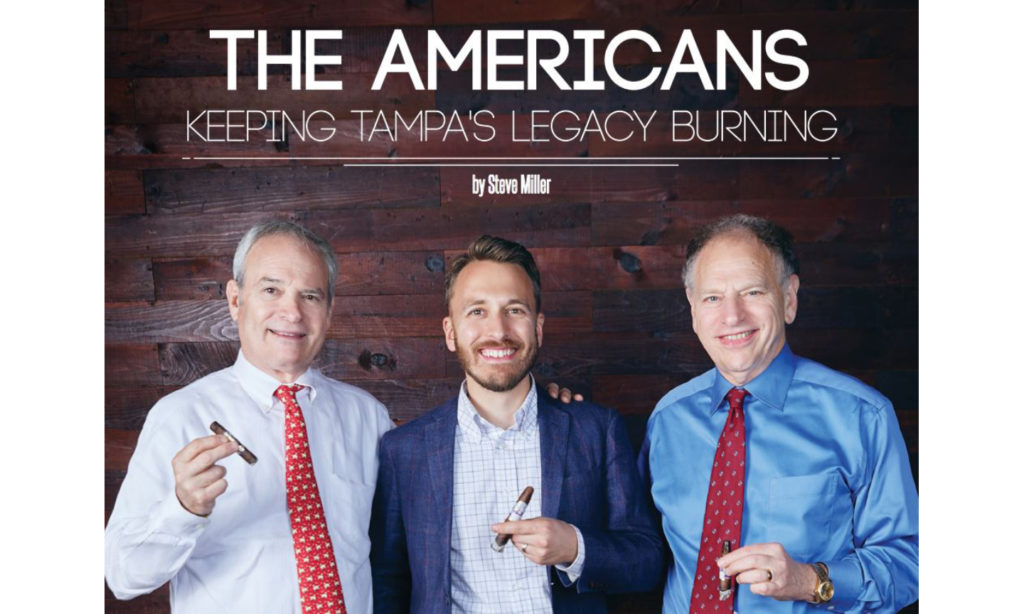The Americans
We’ve done the tourist traps to death, from the theme parks (Dollywood, no thanks) to the roadside stops (really, there’s a cheese castle in Wisconsin?).
Finally, there’s a destination on the horizon that will light up cigar fans: A multi-million dollar overhaul of the J.C. Newman Cigar Co.’s El Reloj cigar factory in Tampa’s Ybor City, which will become a cigar version of the Bourbon Trail, complete with museum, tastings, movies and roll-your-own classes.
The factory is the last operating cigar factory left in the square-mile-sized Ybor district, a 100,000-square-foot monument to the early 20thcentury when 300 million cigars a year came from the teeming domestic cigar industry based there.
“We had 150 cigar factories in Tampa at one time and nowwe’re the last traditional cigar factory in the U.S.,” says Eric Newman, president of J.C. Newman who, along with his brother Bobby, is part of a third generation of leadership of the family-owned company.
his is the 125thanniversary of the business, which started in the frigid north of Cleveland’s east side in 1895 and moved to the balmy tropics of Tampa in the mid-50s.
“We’re using some of the same hand-operated machines my grandfather (J.C. Newman) bought in the 30s,” Eric says. “These aren’t replica machines. I can’t think of any product made on the same machines from that long ago.”
It’s natural to want to show off these functional relics. It’s like going to a natural history museum where the stagecoach still runs.
Which is where the next generation of Newman leadership comes in. The boldly envisioned cigar destination was conceived by Eric’s son, Drew.
“We have this opportunity to create the premier tourist destination for cigars [here] in the U.S.,” Drew says. “Over the past few years, really passionate cigar smokers would go to Latin America to see these modern cigar factories, but the reality for us is that our home is this factory in the middle of Tampa, 15 minutes from the airport, close to Disney and so many other attractions in the state. They can come here to see how cigars are made rather than flying overseas.”
The grand plan has involved moving departments from one part of the building to another, and knocking out parts of the structure for improvements. Along the way, they discovered new treasures that will be part of the tours, including a secret staircase used by the factory manager to hide valuables–thinking some awesome cigars, or less fun, cash–from bandits who made the rounds in the old days.

The Newman cigar experience will also include a theater to screen archived and current cigar themed reels, an event space for corporate events and weddings, and a retooled cigar factory on the third floor to showcase the rolling of the American, J.C. Newman’s cigar, produced using all American parts, from the wrapper and tobacco to the boxes.
“Just as people visit wineries and craft breweries, this is the place to see about cigars,” Drew says. “So much of Florida is new, it’s been built in the last 40 or 50 years, so as a result there’s very little history in Florida. But our factory and the cigar industry in Tampa is one of the things that gives the city history.”
“So much of Florida is new, it’s been built in the last 40 or 50 years, so as a result there’s very little history in Florida. But our factory and the cigar industry in Tampa is one of the things that gives the city history.”
***
To chronicle the story of J.C. Newman Cigar is to narrate a piece of Tampa history. But like so much of the state’s history, it starts with some transplanting. Newman was founded in Cleveland, when Hungarian immigrant Julius Caeser Newman, Eric’s grandfather and Drew’s great-grandfather, bummed $50 for some tobacco and crafted himself a rolling table from some old boards. He was inspired in a most unlikely fashion considering the era –as a pre-teen, spotting the wife of a prominent Hungarian politician on the “veranda of her palace, smoking a long, black cigar,” writes Stanford Newman, J.C.’s son and Eric’s father, in his 1999 memoir, Cigar Family.
Stanford started out selling for J.C. in the 1930s, and he was warned that cigars were not going to be a thing for very long.
“He was pulled aside and told by people to find another line of work because only old men smoke cigars,” Eric says. “But he said, ‘There are new old men born every day,’ and kept going.”
After almost 60 years in the Midwest, J.C. decided to move the family closer to the source of the coveted Cuban tobacco. He bought the Regensburg building a.k.a. El Reloj, or “the clock,” for the chiming timepiece at the top of the structure’s red brick tower.
“We rented the first floor when we first came in 1953,” Eric says. The operation was still Cleveland-based, renting the new location to give it a tryout. It worked, and J.C. Newman Cigar made the move south in 1954. The rolling machines it brought along called for some enhancements to the old building, which until then had housed only hand-rolling.
“We had to put steel beams in once we moved in to hold up the machines on the second floor,” Eric says.
As with almost all of the cigar factories built in the city between 1886 and 1910, it had three stories with the widest side of the building facing north. This is because in the days before electric lights, the best indirect sunlight light –north or south–was needed to discern between the tobacco colors, as the leaves are sorted according to up to 50 different hues.
Stanford succeeded J.C., who died in 1958. Stanford passed away in 2006. Eric is now president and his younger brother Bobby is executive vice president.
“I can’t say I was groomed for this, but it was assumed,” Eric says. Both he and Bobby got their MBAs, and both were part of the business by the end of the 70s, when the cigar industry was robust. Then the 80s saw a drop in demand, and what demand there was shifted from Tampa cigars to those made in Latin America.
And there was rancor in the Newman ranks, as the company was owned by 14 members of the family, all of whom demanded profits as well as a say in operations.
“One of them compared the cigar business to the buggy whip business; adying industry with no future,” Stanford Newman wrote in his memoir. With profits slimming and the family squabbling, Stanford proposed a solution. “The family had a buyout, and myself, Bobby and my father became the decision makers,” Eric says.
And as the newly minted leadership trio considered the debt they had taken on to buy out the family, fortune struck.

Carlos Fuente Sr., owner of Arturo Fuente Cigar, was moving his entire operation to the Dominican Republic and asked Stanford Newman to handle his Tampa machine-made business.
The overture stemmed from a need by Fuente to service customers, particularly in the northeast part of the U.S., who had relied for decades on Fuente-made brands.
The Fuente-made Moya was the go-to smoke among Cuban communities from Miami to New York. It sounded good to Newman. But he had an idea, as well.
In exchange for the Tampa-made cache, Fuente agreed to make La Unica cigars in the Dominican, a premium smoke that was the first high-end cigar to be sold in cellophane bundles rather than a fancy box, passing along the savings to the customer. Up until then, bundled cigars were made from tobacco scraps and were of lesser quality.
“We really didn’t know what we had,” Eric says. “But things took off from there. We handledsales, as Fuente has this great factory but not the sales organization that we did. So our sales guys began selling Fuente, doing what we do best, and Fuente could concentrate on doing what it does best, making cigars.”
By 1990, Fuente was manufacturing Newman’s Cuesta-Rey in addition to the La Unica brands in the Dominican Republic. “It’s a natural alliance,” Stanford told the Tampa Tribune at the time.
“I grew up two blocks from the Newman building,” says Carlos Fuente Jr., who now helms Tabacalera A. Fuente, based in Santiago, Dominican Republic, the largest family-owned premium cigar company in the world.
“I look at the father, Stanford Newman, and he was one of my mentors…they came to Tampa and he did things no one else did,” Fuente says. “His courage was boundless. When people were selling cigars at 30 cents he was at 50-55 cents. He was such a pioneer.”
Longevity, some solid deal-making, and a steadfast ability to move with the industry has sustained J.C. Newman Cigar. The 135 employees at the Ybor factory make 60,000 cigars a day.
Meeting the Newmans in the early 2000s, Jeff Borysiewicz, who owned his own small company, Corona Cigar Co., had some good vibes about the family. Both Newman and Corona were family-run and had the flexibility to make decisions based not on the dictates of a board of directors but “based on doing the right thing,” Borysiewicz says.
It was clear by then that Drew would emerge as the new voice of Newman as the years passed. In 2016, it was Drew who reached out to Borysiewicz, who by then was both running Corona and growing tobacco as the head of his own Florida Sun Grown in Clermont, Fla., to provide the wrapper for a new cigar, the American, featuring all domestic products, from the wrapper to the box.
It was a harbinger of a changing of the guard at Newman, which will see it into the coming years.
***
Eric is 72, hardly old by today’s standards, and by the way, what’s a succession plan?
“We got a call a few years back about a succession plan,” Eric says. “I was 24 when I started here and now I’m 72. So, well, we didn’t really have one.”
The de facto succession plan, it appears, is passion for cigars. And Drew Newman, 38, law degree in hand, is a likely candidate to take the reins when the time comes. The idea for the factory expansion and renovation is Drew’s, to start with. So he’s already developing the future.
“When he was 8 years old, he told us he was J.C. Newman reincarnated,” Eric says of his son. “He was giving factory tours here at 14 years old. He designed a website for us as a teenager. He’s got a real passion and love for this, it’s in his soul. And I have handed that to him.”
Unlike his father and uncle, though, Drew comes to the business with a broader life experience. While he was working tobacco trade shows at 11 years, old, Drew also had an interest in politics and the legal system.
His pursuits led him to Washington D.C., where he got his law degree from American University in 2007. Which led to a judicial clerkship with the D.C. Court of Appeals. Which led to a job as counsel for the Council of the District of Columbia, the local government of Washington D.C.
“I was never pressured to join the family business, and I ended up staying in D.C., building skills and trying to do some good work and help people along the way,” Drew says, speaking by phone from his home in Brooklyn, where he and his wife, Ariel, live with their 4-month-old son.
He’s officially listed as general counsel for J.C. Newman Cigars, but, as his father notes, Drew is likely going to be The Man at Newman in the future. Drew acknowledges his future, and he’s planning on moving his family to Tampa in the coming months.
“I knew that if I wanted to join the business, I should bring some value to it,” he says. Part of that value is the legal acumen and political knowledge it takes to advocate for the industry.
“The saying is that if you are not at the table, you are on the menu, and right now there are a lot of regulation issues that could have an impact on the handcrafted premium cigar business,” he says.
Testifying last year before the U.S. Senate Committee on Small Business & Entrepreneurship, Drew urged committee members to approve a bill that would exempt premium cigars from federal oversights which police availability to minors and addictiveness.
In fact, on any issue that protects the small guy in the cigar business–including the 3,000 specialty retailers that sell premium cigars–Drew advocates for protection.
“We’ve been in this struggle for six years now. Ever since the FDA proposed to expand authority to include all tobacco products in 2014,” he says. “So this effort is to help the FDA understand that premium cigars are different.”
While the law is his specialty and grasping the nuances of what it takes to affect policy is a valuable –and unique–arrow in the cigar maker’s quiver, a producer’s only as good as his or her product and the ability to properly market it.
For example, the American.

Hatched three years ago upon the suggestion of Drew’s wife, who posed the question“ Can a world class cigar still be made in the U.S.?”, the answer was yes.
The American debuted in 2017, uses all domestic products: wrapper from Borysiewicz in Florida, filler from Pennsylvania, binder from Connecticut, boxes from Miami, labels printed in Sanford, Fla., and cellophane tubes from Green Bay, Wisc.
“We were talking about how we’re this oldest family cigar company in America, and she asked, ‘Why don’t you have an American-made cigar?’” Drew says. While small batch distilling and craft brewing were homegrown favorites, there’s no reason cigars can’t get into the game, they agreed.
“People want to support locally made products,” they figured. And they were right.
It almost didn’t get off the ground. The old guard took some convincing. “Drew said, ‘Dad, I want to do this American cigar’ and I said, ‘That’s a lousy idea,’” Eric says.
He was overruled.
The American comes in four sizes, from a 4.5 x 50 Robusto to a 7 x 47 Churchill and is sold exclusively in stores –not online.
The adventurous entrepreneurial spirit, passing through generations, has allowed J.C. Newman Cigar to survive two world wars, a depression, a recession, the Cuban embargo and all the cyclical business twists that an economy weathers.
Add to that now the sweep of the coronavirus.
“Our company was around for the original pandemic,” Eric notes, referring to the 1918 Spanish flu. “During the Great Depression, my grandfather made two-cent cigars to be affordable. And during this, cigar consumption has not tailed off, and we’re very fortunate.”
With that, he makes a prediction.
“We believe that brick and mortar is the future of the industry,” Eric says. “There will be a thinning out of all retailers. But [for cigars] I think consumption will be solid. The smart retailer will be about keeping customers, and keeping that ambience.”
He continues, “We’re on generation No. 4 here…we’re fortunate, we’ve defied the odds.”
Borysiewicz thinks of Newman like Miller Brewing in Milwaukee or Detroit’s Ford Motor Co.in that “You don’t want those things to leave. There’s a reason and a desire to preserve those industries and what they mean to those locations. Newman gives an identity to Tampa.”




